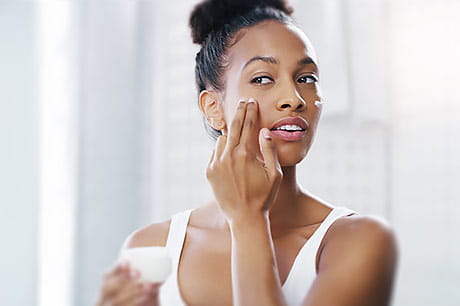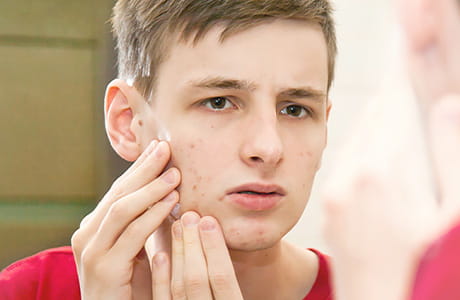What is a chemical peel?
Chemical peels can help to improve skin problems from wrinkles to acne breakouts. Learn more about this skin-resurfacing treatment and if it might be right for you.
If you’ve tried every over the counter product and DIY facial treatment for acne, skin discoloration and wrinkles with no effect, a chemical peel might help. Breanna Bennett, a cosmetic aesthetician at Geisinger Medical Center, walks us through the process of this cosmetic skin treatment.
What is a chemical peel?
A chemical peel, also called a skin peel or face peel, is a procedure that uses a chemical solution to remove the outer layers of skin on your face and can even be used on your neck or hands. This resurfacing procedure can help make your skin look smoother and healthier looking.
Chemical peels can help to improve skin conditions including:
- Acne and breakouts
- Uneven skin tone
- Textured skin
- Discoloration from sun damage, acne or hormones
- Hyper-pigmentation
- Wrinkles
- Fine lines
- Enlarged pores
- Dry skin
- Dullness
“When a chemical peel is applied and removes that outer most layer of skin, it gives your skin the opportunity to produce newer and fresher looking skin in its place,” says Breanna. “Depending on your individual needs, you can have one of four chemical peels: a beta-hydroxy acid, lactic acid, alpha hydroxy acid or trichloroacetic acid chemical peel.”
These different types mean that a chemical peel can be customized to you, which can help you achieve glowing skin.
How to prepare for a chemical peel
In the days leading up to a chemical peel, it’s important to avoid sun exposure, because a chemical peel cannot be applied to sunburned skin.
To help your skin prepare for a peel, there are also several ingredients, products and skin treatments you should avoid beforehand, including:
- Retinoids products (including Retin-A, retinol, Tretinoin and Adapalene)
- Alpha hydroxy acid products (such as glycolic or lactic acid)
- Salicylic acid products
- Hydroquinone products
- Waxing
- Electrolysis
- Masks
- Scrubs and exfoliants
- Tweezing
- Injections
- Microdermabrasion
- Electric face cleaners (such as the Clarisonic brush)
- Loofah
Avoid these products for at least 72 hours before your peel to avoid having any unnecessary skin irritation.
“Another helpful tip is to schedule your chemical peel when you might have some downtime. This can give the redness, peeling and discoloration that’s normal after a chemical peel time to heal without disrupting any social obligations,” says Breanna.
What to expect during a chemical peel
When you arrive for your treatment, your skin will be cleansed twice and prepped with a degreasing solution. “This helps remove any oils from your skin,” says Breanna. “Then, depending on the type of peel you choose, we may perform dermaplaning.”
Dermaplaning is a manual exfoliation technique that uses a razor blade to remove dead skin and vellus facial hair (peach fuzz) from your face. This helps to increase the absorption of the peel, enhance efficacy and reduce possible downtime in the form of visible peeling.
You’ll wear protective goggles while the chemical peel is applied by your aesthetician. “During your peel, you may feel a very light stinging or warmth when the solution is on your skin,” says Breanna. “This is normal and temporary, usually subsiding within a few minutes.”
Depending on the type of chemical peel you’re having, the chemical solution will vary in strength and length of application. Your skin will then either be rinsed with water or neutralized with a peel neutralizer to remove the chemical peel. Some chemical peels are self-neutralizing and will remain on your skin for three hours.
What to expect after a chemical peel
After your procedure is complete, the healing process begins and you’re well on your way to healthier looking skin.
“You may experience redness, mild flaking and tight, dry skin afterwards, which is normal,” says Breanna. “Depending on the type of peel that was used, you may experience some downtime as your skin heals — typically between one and six days.”
Some peels can cause temporary darkening and subsequent flaking. It’s important that you do not peel, rub or pick any of the skin away. Allow your skin to heal naturally after a chemical peel for the best results.
“Make sure you wear a daily mineral sunscreen with a minimum SPF of 30,” says Breanna. “Avoid sweating and exercise for the first 24 hours after your chemical peel and use a gentle cleanser and moisturizer in the days to follow. Skip the exfoliants and harsh acne or anti-aging creams with active ingredients like glycolic or salicylic acid until any visible peeling subsides.”
Your aesthetician will work with you and answer any questions you have before, during and after a chemical peel. You will also receive a post chemical peel instructions handout.
“If you’re thinking about having a chemical peel, or any skin resurfacing service, schedule a skin consultation today,” says Breanna. “We can help you achieve glowing skin with a skin service that’s right for you.”
Next steps:
Looking for more skincare treatments? Learn about microneedling
Interested in a chemical peel? Call today to schedule a consultation at 570-214-7968





